Effect of Expanded Perlite Aggregate Plaster on the Behavior of High-Temperature Reinforced Concrete Structures
Abstract
:1. Introduction
2. Materials and Methods
3. Results and Discussion
High-Temperature Resistance of EPAP Test Plate
4. Conclusions
- This application is important in terms of ensuring building safety because the temperature values measured on the back surface of the test plaster with EP aggregate did not reach a level that would cause a negative effect on the reinforcement and concrete. In the literature, there are studies that reduce the thermal conductivity value with EP applied in different volumes [35].
- As a result of the experiment (at temperatures above 900 °C), both colour change and cracks with a diameter of 10–15 mm occurred in the area exposed to the flame in the NAP. These cracks reached the back surface, but the colour change is not very obvious. Although there was an inconspicuous colour change and capillary crack formation in the area exposed to the flame in EPEP, no colour change or crack formation was observed on the back surfaces.
- As a result of EPAP’s exposure to a flame above 900 °C, no cracks in the plate that would damage the reinforced concrete element were formed. The temperature values measured on the back surface (126–183 °C) as a result of exposure to a flame for three hours are similar to the temperatures measured in other studies [36].
- Water and deteriorating substances can easily enter the reinforced concrete element through cracks formed as a result of the flame, causing corrosion of the reinforcement and fragmentation of the concrete, thus creating a durability problem in reinforced concrete structures. In this context, it is thought that EPAP will give positive results in providing the desired fire resistance and durability.
- In order to prevent the collapse of structures as a result of sudden strength losses that may occur with the heat increase in the reinforcement and concrete during high temperatures, coating the surfaces of the building elements with EPAP could be a solution.
- EPAP could be the material of choice for the stability of structures and structural elements exposed to high temperatures.
- By comparing the experimental data obtained from this study with the results of large-scale EPAP applications to be applied in buildings, future insulation and fire problems in reinforced concrete buildings may be solved.
Author Contributions
Funding
Data Availability Statement
Acknowledgments
Conflicts of Interest
References
- Divyah, N.; Thenmozhi, R.; Neelamegam, M.; Prakash, R. Characterization and behavior of basalt fiber-reinforced lightweight concrete. Struct. Concr. 2021, 22, 422–430. [Google Scholar] [CrossRef]
- Prakash, R.; Raman, S.N.; Divyah, N.; Subramanian, C.; Vijayaprabha, C.; Praveenkumar, S. Fresh and mechanical characteristics of roselle fibre reinforced self-compacting concrete incorporating fly ash and metakaolin. Constr. Build. Mater. 2021, 290, 123209. [Google Scholar] [CrossRef]
- Prakash, R.; Thenmozhi, R.; Raman, S.N.; Subramanian, C. Characterization of eco-friendly steel fiber-reinforced concrete containing waste coconut shell as coarse aggregates and fly ash as partial cement replacement. Struct. Concr. 2020, 21, 437–447. [Google Scholar] [CrossRef]
- Anderberg, Y. Fire Engineering Design of Structures Based on Design Guides. In Proceedings of the 2nd International Conference on Performance-Based Codes & Fire Safety Design Methods, Maui, HI, USA, 7–9 May 1998. [Google Scholar]
- Korjenic, A.; Petránek, V.; Zach, J.; Hroudová, J. Development and performance evaluation of natural thermal-insulation materials composed of renewable resources. Energy Build. 2011, 43, 2518–2523. [Google Scholar] [CrossRef]
- Abu-Jdayil, B.; Mourad, A.-H.; Hittini, W.; Hassan, M.; Hameedi, S. Traditional, state-of-the-art and renewable thermal building insulation materials: An overview. Constr. Build. Mater. 2019, 214, 709–735. [Google Scholar] [CrossRef]
- Handbook, A. Thermal Performance of Masonry Walls Insulated with Perlite; Perlite Institute, Inc.: Harrisburg, PA, USA, 1982. [Google Scholar]
- Papadopoulos, A.M.; Giama, E. Environmental performance evaluation of thermal insulation materials and its impact on the building. Build. Environ. 2007, 42, 2178–2187. [Google Scholar] [CrossRef]
- Pargana, N.; Pinheiro, M.D.; Silvestre, J.D.; de Brito, J. Comparative environmental life cycle assessment of thermal insulation materials of buildings. Energy Build. 2014, 82, 466–481. [Google Scholar] [CrossRef]
- Barreira, E.; de Freitas, V.P. Experimental study of the hygrothermal behaviour of External Thermal Insulation Composite Systems (ETICS). Build. Environ. 2013, 63, 31–39. [Google Scholar] [CrossRef]
- Abu-Jdayil, B.; Al-Malah, K. Jordanian Clay-Based Heat Insulator Composites: Mechanical Properties. J. Reinf. Plast. Compos. 2008, 27, 1559–1568. [Google Scholar] [CrossRef]
- Ashrae, H. ASHRAE Fundamental Handbook; American Society of Heating Refrigeration and Air-Conditioning Engineers: Atlanta, GA, USA, 2001; p. 30. [Google Scholar]
- Tuzcu, H. Experimental Investigation of Flammability and Combustion Characteristics of Fire Resistant Polyurethane Based Materials used in Thermal Insulation and Automotive Industries. Master’s Thesis, Pamukkale University, Institute of Science and Technology, Mechanical Engineering, Denizli, Turkey, July 2010. Available online: http://acikerisim.pau.edu.tr:8080/xmlui/handle/11499/1452 (accessed on 21 December 2022).
- Cvetkovska, M.; Knezevic, M.; Xu, Q.; Chifliganec, C.; Lazarevska, M.; Gavriloska, A.T. Fire scenario influence on fire resistance of reinforced concrete frame structure. Procedia Eng. 2018, 211, 28–35. [Google Scholar] [CrossRef]
- Bilow, D.N.; Kamara, M.E. Fire and Concrete Structures. In Structures 2008: Crossing Borders; American Society of Civil Engineers: Reston, VA, USA, 2008; Volume 2, pp. 429–447. Available online: https://ascelibrary.org/doi/epdf/10.1061/41016%28314%29299 (accessed on 21 December 2022).
- Kim, M.; Kim, T.; Yeo, I.-H.; Lee, D.; Cho, H.; Kang, K.-I. Improvement of standards on fire safety performance of externally insulated high-rise buildings: Focusing on the case in Korea. J. Build. Eng. 2021, 35, 101990. [Google Scholar] [CrossRef]
- Hossain, K.M.A.; Lachemi, M. Mixture design, strength, durability, and fire resistance of lightweight pumice concrete. ACI Mat. J. 2007, 104, 449–457. [Google Scholar]
- Tayeh, B.A.; Zeyad, A.M.; Agwa, I.S.; Amin, M. Effect of elevated temperatures on mechanical properties of lightweight geopolymer concrete. Case Stud. Const. Mater. 2021, 15, e00673. [Google Scholar] [CrossRef]
- Vaou, V.; Panias, D. Thermal insulating foamy geopolymers from perlite. Miner. Eng. 2010, 23, 1146–1151. [Google Scholar] [CrossRef]
- Gao, H.; Liu, H.; Liao, L.; Mei, L.; Shuai, P.; Xi, Z.; Lv, G. A novel inorganic thermal insulation material utilizing perlite tailings. Energy Build. 2019, 190, 25–33. [Google Scholar] [CrossRef]
- Akyuncu, V.; Sanliturk, F. Investigation of physical and mechanical properties of mortars produced by polymer coated perlite aggregate. J. Build. Eng. 2021, 38, 102182. [Google Scholar] [CrossRef]
- Fang, Y.; Yin, X.; Cui, P.; Wang, X.; Zhuang, K.; Ding, Z.; Xing, F. Properties of magnesium potassium phosphate cement-expanded perlite composites applied as fire resistance coating. Constr. Build. Mater. 2021, 293, 123513. [Google Scholar] [CrossRef]
- Summaries, M.C. Mineral Commodity Summaries; US Geological Survey: Reston, VA, USA, 2020. [Google Scholar]
- Uluer, O.; Aktaş, M.; Karaağaç, İ.; Durmuş, G.; Khanları, A.; Ağbulut, Ü.; Çelik, D.N. Manufacturing of expanded perlite based heat insulation material using theoretical thermal coanductivity prediction model results. In Proceedings of the International Conference on Progress in Applied Science 2017 (ICPAS 2017), Istanbul, Turkey, 4–6 January 2017. [Google Scholar]
- ETI Holding Company. Perlite and insulation in energy saving. Bull. Chamber Civ. Eng. 2003, 67, 37–38. [Google Scholar]
- Tian, Y.L.; Guo, X.L.; Wu, D.L.; Sun, S.B. A Study of Effect Factors on Sodium Silicate Based Expanded Perlite Insulation Board Strength. Appl. Mech. Mater. 2013, 405, 2771–2777. [Google Scholar] [CrossRef]
- Topçu, I.B.; Işıkdağ, B. Manufacture of high heat conductivity resistant clay bricks containing perlite. Build. Environ. 2007, 42, 3540–3546. [Google Scholar] [CrossRef]
- Zhang, Y.; Huang, X.; Wang, Q.; Ji, J.; Sun, J.; Yin, Y. Experimental study on the characteristics of horizontal flame spread over XPS surface on plateau. J. Hazard. Mater. 2011, 189, 34–39. [Google Scholar] [CrossRef] [PubMed]
- Rossi, M.; Camino, G.; Luda, M.P. Characterisation of smoke in expanded polystyrene combustion. Polym. Degrad. Stab. 2001, 74, 507–512. [Google Scholar] [CrossRef]
- Jiang, L.; Xiao, H.; An, W.; Zhou, Y.; Sun, J. Correlation study between flammability and the width of organic thermal insulation materials for building exterior walls. Energy Build. 2014, 82, 243–249. [Google Scholar] [CrossRef]
- Fu, L.; Wang, Q.; Ye, R.; Fang, X.; Zhang, Z. A calcium chloride hexahydrate/expanded perlite composite with good heat storage and insulation properties for building energy conservation. Renew. Energy 2017, 114, 733–743. [Google Scholar] [CrossRef]
- Perlite Institute. Perlite Aggregate for Lightweight Insulating Concrete, 10th ed.; Perlite Institute: New York, NY, USA, 1956; pp. 1–4. [Google Scholar]
- Persan. Modern Hayatin Incisi Perlit. Available online: http://www.persanyapi.com.tr/assets/images/kataloglar/kataloglar__921681568713029_dc_.pdf (accessed on 10 January 2023).
- Peng, G.F.; Jiang, Y.C.; Li, B.H.; Zhang, J.; Shi, Y.X. Effect of high temperature on hardened concrete. Mater. Res. Innov. 2014, 18 (Suppl. S2), 290–293. [Google Scholar] [CrossRef]
- Rashad, A.M.; Essa, G.M.F.; Morsi, W.M. Traditional Cementitious Materials for Thermal Insulation. Arab. J. Sci. Eng. 2022, 47, 12931–12943. [Google Scholar] [CrossRef]
- Ariyaratne, I.E.; Ariyanayagam, A.; Mahendran, M. Bushfire-Resistant Lightweight Masonry Blocks with Expanded Perlite Aggregate. Fire 2022, 5, 132. [Google Scholar] [CrossRef]
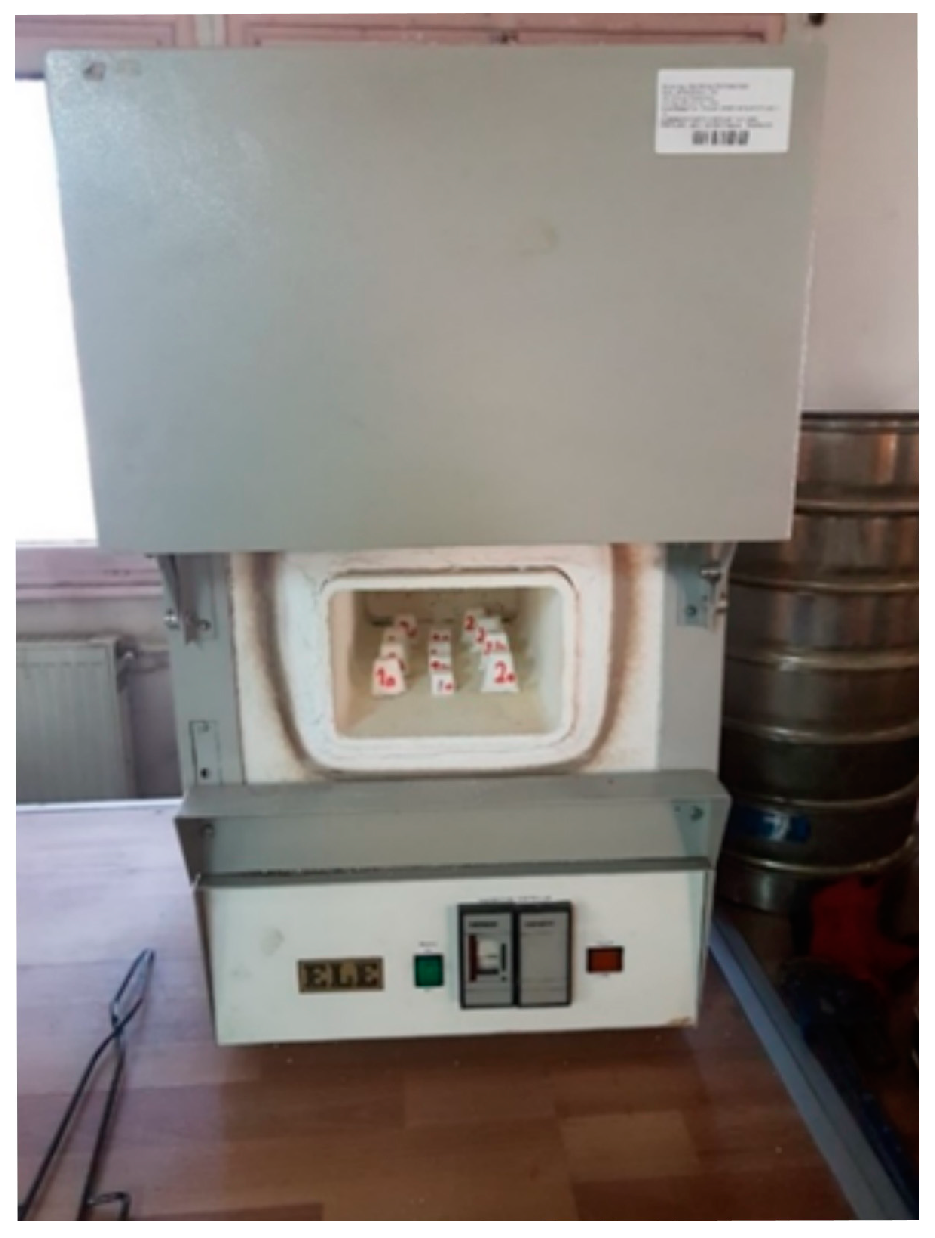
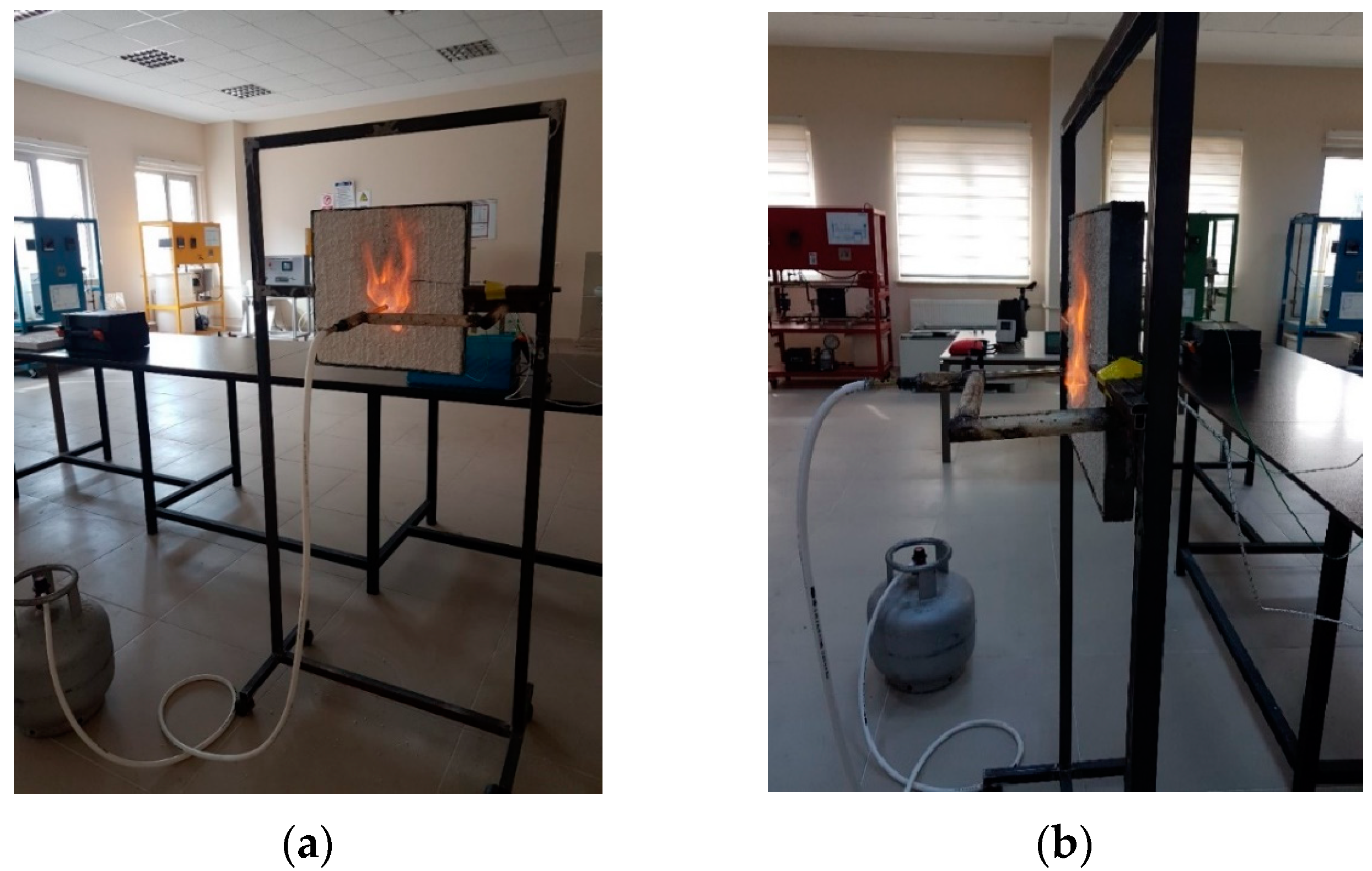

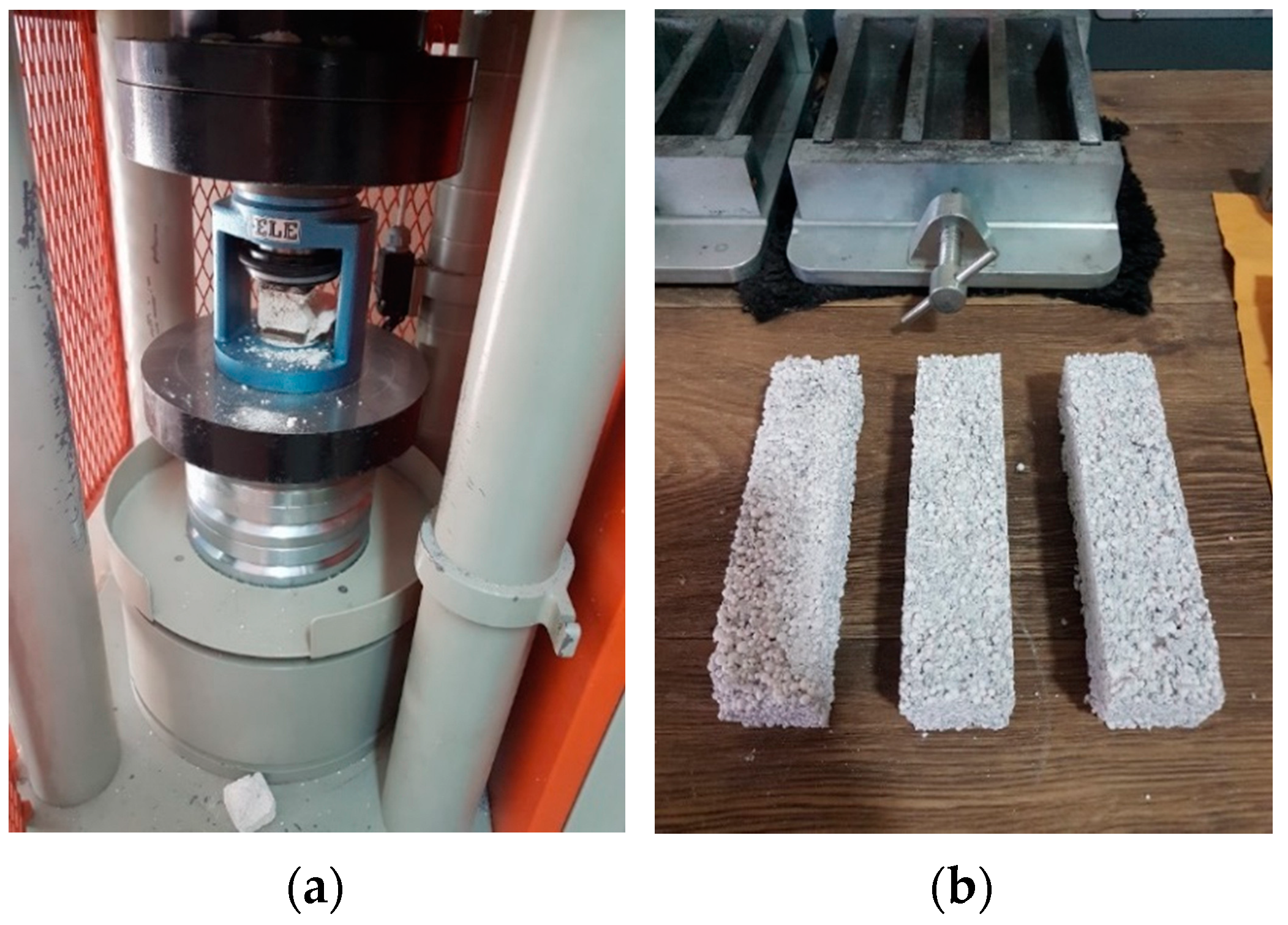

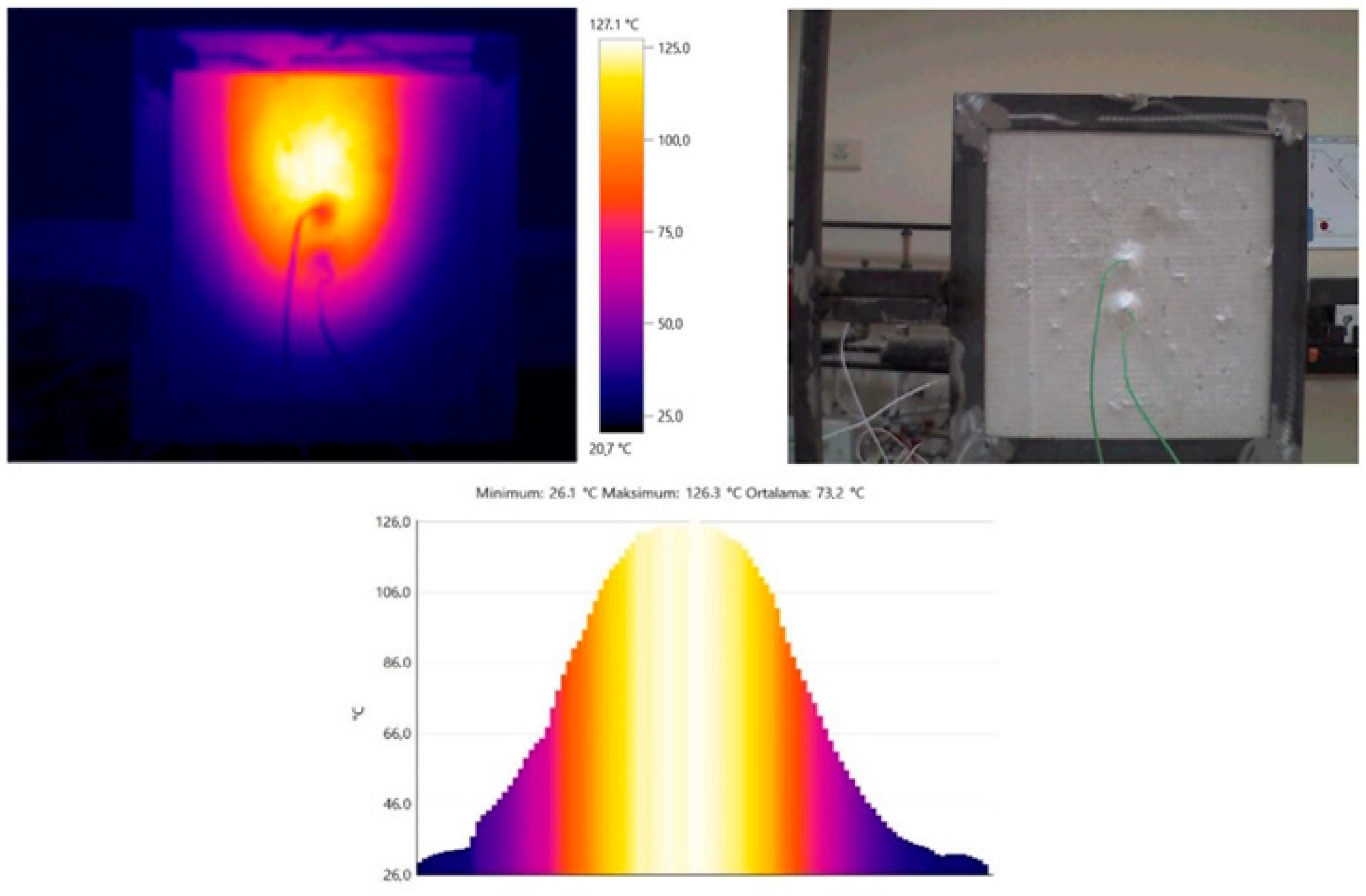
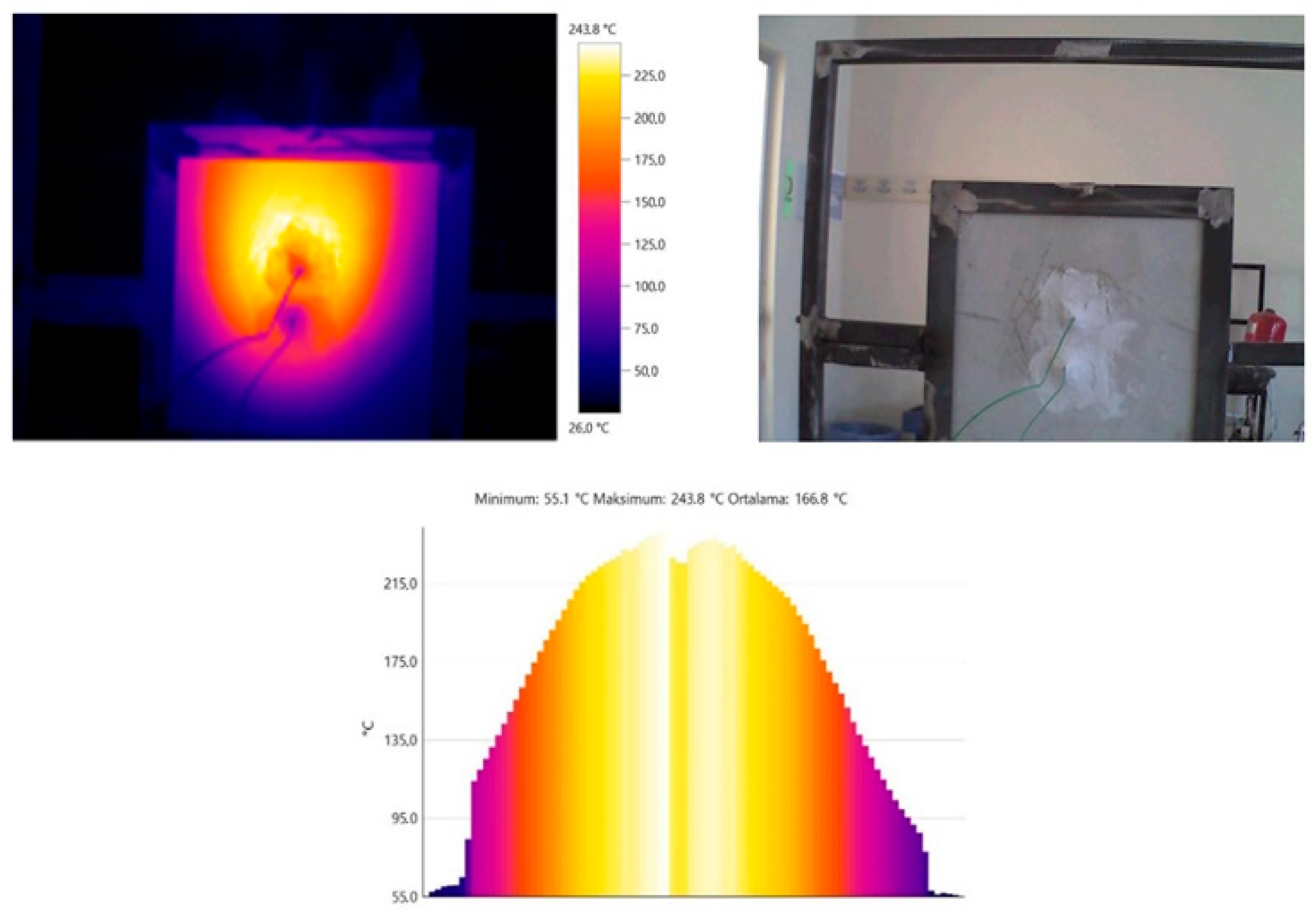

| Physical Properties | |
|---|---|
| Colour | White |
| Softening point (ore) | 900–1100 °C |
| Melting point (ore) | 1260–1343 °C |
| Specific heat | 0.20 kcal/kg °C |
| Rough (Expanded) density | 80–160 kg/m3 |
| Thermal conductivity (Expansion) | 0.05 W/mK |
Disclaimer/Publisher’s Note: The statements, opinions and data contained in all publications are solely those of the individual author(s) and contributor(s) and not of MDPI and/or the editor(s). MDPI and/or the editor(s) disclaim responsibility for any injury to people or property resulting from any ideas, methods, instructions or products referred to in the content. |
© 2023 by the authors. Licensee MDPI, Basel, Switzerland. This article is an open access article distributed under the terms and conditions of the Creative Commons Attribution (CC BY) license (https://creativecommons.org/licenses/by/4.0/).
Share and Cite
Ulusu, İ.; Kurnuç Seyhan, A. Effect of Expanded Perlite Aggregate Plaster on the Behavior of High-Temperature Reinforced Concrete Structures. Buildings 2023, 13, 384. https://doi.org/10.3390/buildings13020384
Ulusu İ, Kurnuç Seyhan A. Effect of Expanded Perlite Aggregate Plaster on the Behavior of High-Temperature Reinforced Concrete Structures. Buildings. 2023; 13(2):384. https://doi.org/10.3390/buildings13020384
Chicago/Turabian StyleUlusu, İsmet, and Aslıhan Kurnuç Seyhan. 2023. "Effect of Expanded Perlite Aggregate Plaster on the Behavior of High-Temperature Reinforced Concrete Structures" Buildings 13, no. 2: 384. https://doi.org/10.3390/buildings13020384
APA StyleUlusu, İ., & Kurnuç Seyhan, A. (2023). Effect of Expanded Perlite Aggregate Plaster on the Behavior of High-Temperature Reinforced Concrete Structures. Buildings, 13(2), 384. https://doi.org/10.3390/buildings13020384






